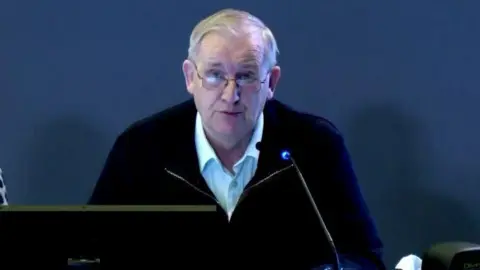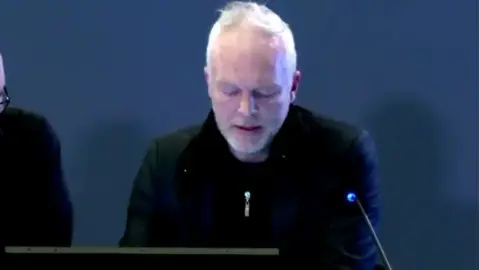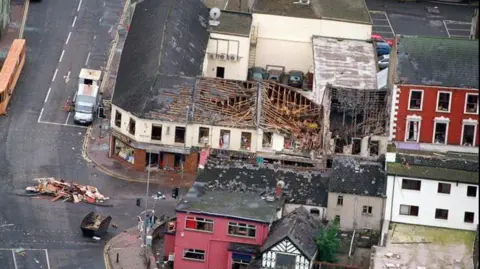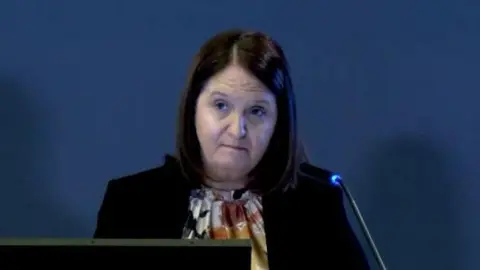Survivor says 'world stood still' after bomb went off
 Omagh Bombing Inquiry
Omagh Bombing InquiryWarning: This page contains distressing details
A man who survived the Omagh bombing has said that "the world stood still for 30 or 40 seconds", after it happened.
Jim Sharkey, who ran a newsagent shop in the County Tyrone town, was among those speaking at the inquiry into the 1998 bombing.
Mr Sharkey told the inquiry that he had spoken to four of those who were killed before the explosion.
"All I could see in the street were bodies lying everywhere, a lot of people screaming, ambulances arriving," he said.
He described meeting Kevin Skelton who was looking for his wife Mena.
"I will never forget the look on that man's face," he said.
She had died in a clothes shop on the opposite side of the road from his newsagents.
He had chatted to Geraldine Breslin and Ann McCombe in the street and Sean McGrath and Libbi Rush had come into his shop.
"I keep thinking if Sean, Libbi, Geraldine and Ann had stayed where they were, would they have been safe?," he said.
He still avoids coming into the town on a Saturday afternoon because it "brings back so many memories".
"It wasn't the same Omagh. It wasn't in my eyes anyway."
Blown off his feet
 Omagh Bombing Inquiry
Omagh Bombing InquiryDavid McSwiggan said his personal statement, which he delivered to the inquiry this morning, had been written "with great difficulty".
He described how he was blown off his feet and knocked unconscious by the force of the blast.
He had been in the town to meet a group of friends who were taking part in a community carnival that afternoon when the bomb that killed 29 people, including a woman pregnant with twins, exploded.
The group had been sceptical that the bomb scare at the courthouse was real and the Troubles usually happened in other places, he told the Omagh Bombing Inquiry.
Mr McSwiggan said they thought the County Tyrone town was "a backwater" that did not merit to be a target, especially as the Troubles were supposed to be over.
He described going back into the flames and smoke to look for his friends, looking at the dead and injured to see if he could recognise them.
As he called out his friends' names, he tried to ignore and not be overwhelmed by the horrific devastation.
Anxiety and depression
He contacted his mother who worked as an operating theatre nurse at the Tyrone County Hospital to tell her what had happened and that she and her colleagues were desperately needed.
"Selfishly all I wanted then, at that moment, was the comfort and security that only a mother can provide but I also knew that nothing would ever be the same for us again.
"She too would have to see the depraved obscenity I had just witnessed inflicted on our neighbours."
His mother never spoke about what she saw or experienced.
"I can't comprehend what she went through that day, doing her duty to help people in need," he said.
"I am immensely proud of her professionalism and that of her colleagues [which] was so sorely and cruelly tested that day. "
He said the trauma he experienced led to anxiety and depression and eventually the collapse of an 18-year relationship and the loss of his teaching job.
He said he only began proper trauma-informed psychotherapy in 2022.
"The idea that you could be in your local town on a Saturday afternoon and everyone is rounded up and killed in front of you and nobody really knows why or how or who did it and you're supposed to just go on with your life and never mention it again," he reflected.
 Press Association/MoD
Press Association/MoDSuzanne Travis was standing metres from the bomb with her mother when it exploded.
She said she never lost consciousness and there was an eerie silence before the sounds of screaming, alarms, panic and chaos.
She realised there were two bodies lying beside her. She feared one was her mum but then saw her sitting in the middle of the road some distance away.
She said she felt no pain. She looked down at her two legs and realised that her left foot was missing.
Despite her horrific injuries she was able to return to university and completed her teaching degree, graduating with the same year group with which she had started.
She says not a day goes by where she is not in pain.
 Omagh Bombing Inquiry
Omagh Bombing Inquiry"Little did I know that a lovely summer's day in Omagh all those years ago would turn into the worst day of our lives and would result in my mother and I living with lifelong disabilities," she said.
"The men who carried out this atrocity drove away that day and left behind carnage, devastation and suffering.
"They didn't care they ruined many, many lives, mine included, and for what?
"I will never forgive them for the cowardly, wicked, act that took so much away from my family and I."
Doors used as 'makeshift stretchers'
A woman who helped organise a festival on the day of the bomb said many more children would have been caught in the blast if the event had not been running late.
In a written statement to the inquiry, Lisa McGonigle described hearing what sounded like a car door being slammed and thinking it was a controlled explosion.
Then she saw two police vans going past with legs "lying out of the back" and knew something was "badly wrong".
Worried that children from the parade had been caught in the blast, she went to the hospital and spent two hours there witnessing distressing scenes.
Ms McGonigle went to outpatients where she saw a girl she knew who had lost a limb after she had been blown "through the shoe shop window".
Inside the hospital, she recalls being "handed an injured baby".
"I turned around to see patients being carried in on doors which were being used as makeshift stretchers.
"I think all of them unfortunately were dead."
Ms McGonigle said those memories are still triggered whenever she visits hospitals.
What was the Omagh bomb?
The bomb that devastated Omagh town centre in August 1998 was the biggest single atrocity in the history of the Troubles in Northern Ireland.
Twenty-nine people were killed, including nine children, a woman pregnant with twins, and three generations of one family.
It came less than three months after the people of Northern Ireland had voted yes to the Good Friday Agreement.
Who carried out the Omagh bombing?
Three days after the attack, the Real IRA released a statement claiming responsibility for the explosion.
It apologised to "civilian" victims and said its targets had been commercial.
Almost 27 years on, no-one has been convicted of carrying out the murders by a criminal court.
In 2009, a judge ruled that four men - Michael McKevitt, Liam Campbell, Colm Murphy and Seamus Daly were all liable for the Omagh bomb.
The four men were ordered to pay a total of £1.6m in damages to the relatives, but appeals against the ruling delayed the compensation process.
A fifth man, Seamus McKenna, was acquitted in the civil action and later died in a roofing accident in 2013.
The public inquiry
After years of campaigning by relatives, the public inquiry was set to up examine if the Real IRA attack could have been prevented by UK authorities.
This phase of the inquiry is continuing to hear powerful individual testimonies from relatives who lost loved ones in the explosion.
The bombers planned and launched the attack from the Republic of Ireland and the Irish government has promised to co-operate with the inquiry.
However, the victims' relatives wanted the Irish government to order its own separate public inquiry.
Dublin previously indicated there was no new evidence to merit such a move.
